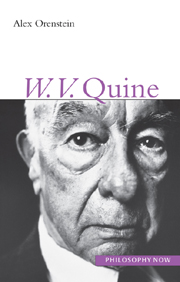3 - Deciding on an ontology
Summary
Some rival twentieth-century ontologies
To appreciate Quine's own ontological commitments, it would be helpful to review some alternatives that were accepted by his contemporaries. These will be discussed in three groups: (1) different kinds of concrete individuals, (2) different objects for mathematics and set theory and (3) the positing of intensional objects.
Among the different candidates for being a concrete individual, two stand out. Some philosophers hold that phenomenal objects are the basic individuals, whereas others maintain that physical objects are the concrete values of our individual variables. Theorists of the first group have been called phenomenalists and its members included Berkeley, Hume and Mill. In the twentieth century, Russell, Carnap, Ayer and Goodman have held this view. The phenomenalists' individual is an appearance or sense datum. An example would be the brownish appearance associated with the desk before me. One of the basic problems for the phenomenalist is to explain other concrete objects in terms of his phenomenal ones, for example, to define physical objects such as the desk in terms of sense data. Thus J. S. Mill spoke of physical objects as permanent possibilities of sensation. Twentieth-century phenomenalists take a more linguistic approach to this problem: how can we translate sentences about physical objects, for example, ‘This is a desk’, into sentences (observation sentences) about phenomenal objects, for example, ‘This is a brownish sense datum’ or ‘There is a brownish sense datum here and now’?
Theorists of the second group hold that physical objects are basic and do not need to be reduced to phenomenal ones.
- Type
- Chapter
- Information
- W. V. Quine , pp. 39 - 74Publisher: Acumen PublishingPrint publication year: 2002



